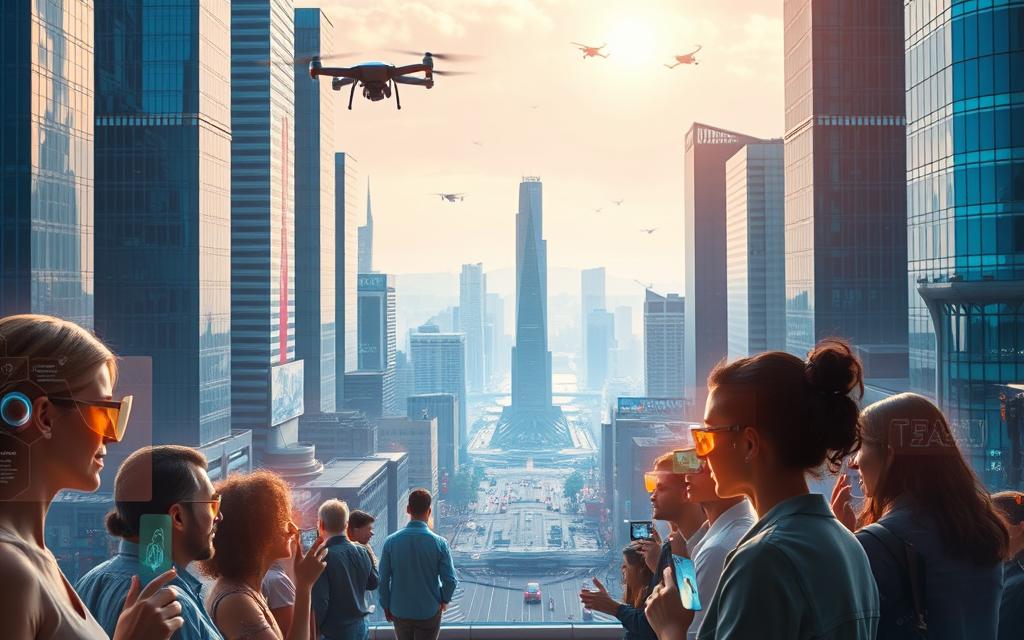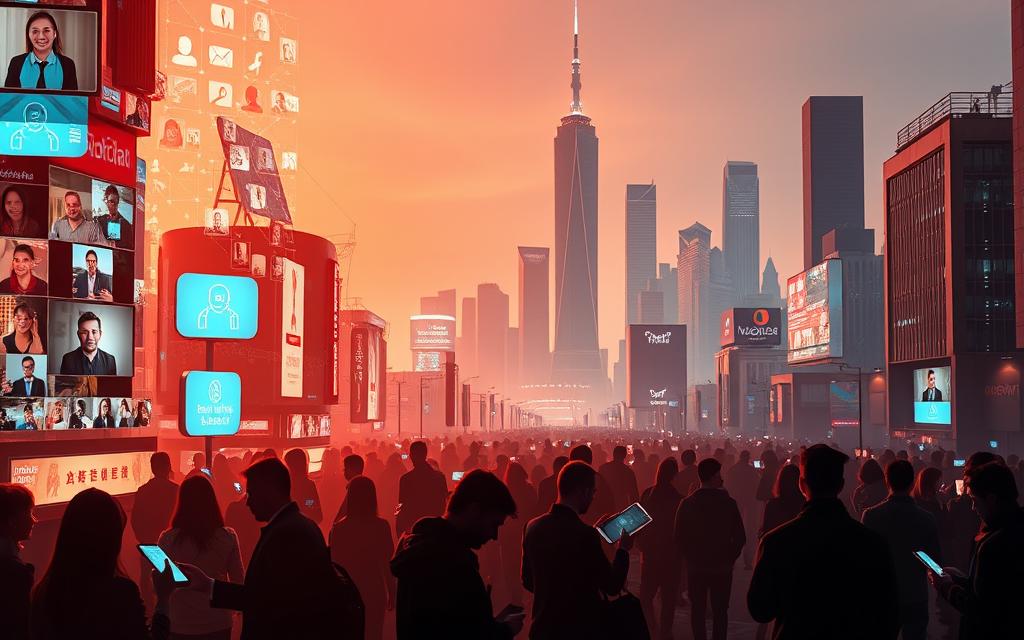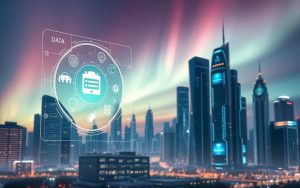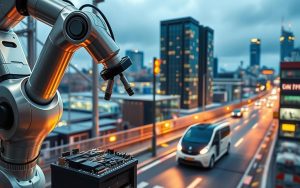Our lives are deeply intertwined with modern advancements. From the moment alarms wake us to the way we connect on social media, technology shapes every aspect of daily routines. This era is defined by integrated systems that drive efficiency and innovation.
Different age groups experience these advancements uniquely. While younger generations embrace digital tools effortlessly, older ones often blend analog and digital methods. This coexistence highlights how perspectives influence adoption and usage.
Key drivers like AI, IoT, and cloud computing are transforming the world. These innovations are not just trends but foundational elements of our today. Understanding their impact helps us navigate the evolving landscape effectively.
Introduction: The Age of Digital Transformation
The digital age has reshaped how people interact with the world. From social media to advanced data systems, these tools are now integral to daily life. However, adoption rates vary widely across different age groups, creating a unique paradox.
While younger digital natives embrace these advancements effortlessly, older generations often approach them with caution. For example, Baby Boomers remember rotary phones, while Gen Alpha grows up with AI-driven devices. This contrast highlights how experiences shape tech adoption.
Data usage is another critical concern. A 2023 survey revealed that 67-81% of adults worry about how their data is used beyond collection. This concern is particularly strong among Baby Boomers, who prioritize privacy, according to British GWI findings.
Meanwhile, Gen Z prioritizes learning new tech skills, with 76% actively seeking to enhance their digital expertise. Forbes notes that this group expects real-time communication, reflecting their comfort with modern tools.
To meet these evolving demands, institutions like AMU are designing IT programs tailored to the modern workforce. These initiatives ensure that all generations can thrive in a digitally-driven world.
“The future belongs to those who can adapt to the digital landscape,” says a Forbes report.
As we navigate this era, understanding these generational differences is key. PBS’s multigenerational content strategies serve as excellent models for adaptation, ensuring inclusivity in a rapidly changing world.
Defining the Current Technological Generation
The evolution of technology has redefined how we live and work. From smartphones to AI-driven tools, these advancements are reshaping industries and daily routines. This era is marked by rapid innovation and seamless integration of digital systems.
The Digital Revolution: A Historical Perspective
The journey from the Industrial Revolution to today’s AI dominance highlights the transformative power of innovation. Early breakthroughs in machinery paved the way for digital tools, which now dominate every sector. Over the years, hybrid cloud adoption has surged, with enterprises leveraging its flexibility and scalability.
IoT has grown exponentially, from 15 billion devices in 2015 to a projected 75 billion by 2025. This growth underscores the increasing connectivity of our world. Meanwhile, cybersecurity has evolved from basic firewalls to zero-trust architectures, addressing modern threats effectively.
Key Characteristics of Today’s Technology
Modern technology is defined by its adaptability and efficiency. API-first development has become the industry standard, enabling seamless integration across platforms. Robotics and AI are now integral to education, with institutions like AMU incorporating them into their curricula.
Smartphones are ubiquitous, with 90% of Millennials owning one. Gen Z, projected to make up 75% of the workforce by 2025, prioritizes digital skills and real-time communication. These trends reflect the growing reliance on technology in both personal and professional spheres.
“The pace of change is unprecedented, and adaptability is key to thriving in this era,” notes an industry expert.
As we navigate this dynamic landscape, understanding these characteristics is essential. They not only define our present but also shape the future of innovation.
What Generation of Technology Are We In?
Innovation is accelerating at an unprecedented pace, shaping industries and daily life. Many experts argue that we are living in the Cognitive Computing Age, where AI and machine learning drive decision-making. This era is marked by intelligent systems that learn, adapt, and evolve.

The rollout of 5G networks has been a game-changer. Compared to previous generations, 5G offers faster speeds and lower latency. This advancement supports the expansion of IoT, enabling seamless connectivity across devices. Edge computing further enhances this by processing data closer to the source, reducing delays.
Blockchain adoption varies across sectors. In finance, it’s revolutionizing transactions with transparency and security. In healthcare, it’s improving data integrity and patient privacy. These applications highlight the versatility of modern platforms.
“The integration of AR and VR into workforce training is transforming skill development,” notes a KCRW report.
Educational institutions like AMU are leading the charge with cloud computing certification programs. These initiatives prepare professionals for the demands of today’s tech-driven economy. As Gen Z enters the workforce, their digital proficiency is reshaping workplace expectations.
| Technology | Impact |
|---|---|
| 5G Networks | Enhanced speed and IoT connectivity |
| Edge Computing | Reduced latency for real-time processing |
| Blockchain | Improved security in finance and healthcare |
| AR/VR Training | Innovative skill development methods |
As we navigate this dynamic landscape, understanding these advancements is crucial. They define our present and shape the future of innovation.
Generational Perceptions of Technology
Each generation interacts with advancements in unique ways, shaping their experiences and preferences. From baby boomers to digital natives, these differences highlight how age influences adoption and usage. Understanding these perspectives is key to navigating the modern landscape.
Baby Boomers and Technology Adoption
Baby boomers, born between 1946 and 1964, often approach technology with caution. Many prefer traditional methods like email over newer platforms like TikTok. However, the pandemic accelerated their adoption of tools like telehealth, with usage rates increasing significantly.
Smart home devices are another area where generational divides emerge. While younger groups embrace these innovations, baby boomers often prioritize simplicity and reliability. This contrast underscores the importance of designing user-friendly solutions for all age groups.
Millennials and Gen Z: Digital Natives
Millennials and Gen Z, the true digital natives, have grown up with smartphones and social media. Forbes data shows that 81% of Gen Z prefers mobile-optimized interfaces, reflecting their comfort with modern tools. Meanwhile, 26% of Millennials choose jobs based on meaningful tech impact, highlighting their desire for purpose-driven work.
Workplace trends also reveal generational differences. Millennials drive SaaS adoption, while Gen Z actively participates in the creator economy, with 83% involved in content creation. These behaviors demonstrate their innovative and entrepreneurial spirit.
| Generation | Technology Preference | Key Trend |
|---|---|---|
| Baby Boomers | Email, Telehealth | Post-pandemic adoption |
| Millennials | SaaS, Social Media | Purpose-driven work |
| Gen Z | Mobile-Optimized Interfaces | Creator economy participation |
As technology continues to evolve, understanding these generational perceptions is crucial. It ensures that innovations meet the needs of all users, fostering inclusivity and progress.
The Role of Data Management in Modern Technology
Data management has become a cornerstone of modern advancements. From healthcare to finance, effective strategies ensure accuracy, security, and accessibility. As organizations rely on vast amounts of information, robust systems are essential for success.

IBM defines data management infrastructure as a combination of storage, processing, and analytics tools. These components work together to handle complex datasets efficiently. For example, data lakes store raw information, while warehouses organize it for analysis.
Big Data and Its Implications
Big data is transforming industries by providing actionable insights. Healthcare, for instance, uses it to improve patient outcomes through predictive analytics. However, managing such vast datasets requires advanced methods and technologies.
GDPR compliance remains a challenge for multinational corporations. Balancing data accessibility with privacy regulations is critical. Companies must adopt transparent practices to build trust with users.
Generational Views on Data Privacy
Generational differences shape how people perceive data privacy. Pew Research reveals that 72% of Gen Z is open to sharing information, compared to 41% of boomers. This contrast highlights varying comfort levels with digital transparency.
Healthcare data interoperability is another area of concern. Older generations often prefer manual handling, while younger ones embrace automated systems. Institutions like AMU are addressing these gaps through tailored data science programs.
“Transparency in data usage fosters trust and accountability,” notes a KCUR report.
| Generation | Data Sharing Preference | Key Concern |
|---|---|---|
| Gen Z | 72% Open Sharing | Transparency |
| Millennials | 58% Conditional Sharing | Security |
| Boomers | 41% Open Sharing | Privacy |
As technology evolves, understanding these perspectives ensures inclusive and effective data management strategies.
Communication in the Digital Age
From Morse code to instant messaging, communication has evolved rapidly. Today, digital platforms enable real-time interactions across the globe. This transformation has reshaped how people connect, both personally and professionally.

Generational preferences play a significant role in shaping these interactions. For instance, 68% of Gen Z prefers visual messaging apps like Snapchat, according to Deloitte. Meanwhile, 59% of Boomers still value landline communication, as reported by the FCC.
Evolution of Communication Technologies
The journey from telegraphs to quantum encryption highlights the pace of innovation. Early methods like Morse code laid the foundation for today’s instant messaging and video calls. Tools like Zoom have become essential, with market penetration spanning all age groups.
Emoji and Bitmoji usage also reflects generational divides. Younger users embrace these visual elements, while older generations often prefer traditional text. This contrast underscores the importance of adaptable platforms.
Generational Preferences in Communication
Enterprise UCaaS adoption varies by age. While younger employees embrace unified communication tools, older workers may face barriers due to unfamiliarity. PBS’s multigenerational streaming strategies offer valuable insights into bridging these gaps.
Email response times further highlight differences. Boomers typically reply within 24 hours, while Gen Z averages just 4 hours. These behaviors reflect varying comfort levels with digital devices.
“Adapting to diverse communication styles ensures inclusivity in the workplace,” notes a PBS report.
Educational institutions like AMU are addressing these challenges. Their network administration courses equip students with skills to manage modern communication systems effectively. This prepares them for roles in family-owned businesses or large organizations.
The Future of Technology: What Lies Ahead?
The future of technology promises transformative changes across the globe. From space-based internet to bio-digital interfaces, these advancements are set to redefine how we live and work. The pace of innovation is accelerating, and staying ahead requires adaptability and foresight.

Emerging Technologies and Trends
Neuromorphic computing is gaining traction, with R&D timelines indicating significant breakthroughs by 2030. This approach mimics the human brain, enabling faster and more efficient processing. Similarly, space-based internet projects like Starlink aim to provide global connectivity, bridging gaps in remote areas.
Bio-digital interfaces are another exciting frontier. Prototypes are being developed to merge biological systems with digital devices, opening new possibilities in healthcare and beyond. These technologies are not just futuristic concepts but tangible innovations shaping the world.
Preparing for the Next Technological Generation
As the internet of Things (IoT) expands, GSMA Intelligence predicts 50 billion connected devices by 2030. This growth underscores the need for robust cybersecurity measures. AMU’s cybersecurity degree programs are seeing increased enrollment, reflecting the demand for skilled professionals.
Quantum computing is another game-changer, with industry-specific impacts expected in finance, healthcare, and logistics. Upskilling programs are crucial, with 73% of IT leaders prioritizing training to keep pace with these advancements. Adaptive education models are also emerging, ensuring continuous learning in a rapidly evolving landscape.
“The future belongs to those who embrace innovation and invest in lifelong learning,” notes an industry expert.
Gen Alpha’s adoption of AI tutors highlights the shift toward personalized education. These tools cater to individual learning styles, preparing the next generation for a tech-driven world. By fostering adaptability and curiosity, we can ensure a seamless transition into the next era of development.
Conclusion: Embracing the Current Technological Era
Navigating the current era requires embracing innovation while balancing privacy. Cross-generational adoption patterns reveal how different age groups interact with advancements. From kids mastering digital tools to older generations adapting to telehealth, inclusivity remains key.
Continuous learning is essential. Programs like AMU’s IT certifications prepare professionals for the evolving landscape. Public media’s adaptive fundraising successes, such as MASTERPIECE’s streaming innovations, demonstrate the power of staying relevant.
Inclusive UX design philosophies ensure technology meets diverse needs. AI is predicted to bridge generational gaps, offering tailored solutions for all users. As enterprises become 94% cloud-dependent, the focus must shift to balanced innovation and privacy.
This era presents unparalleled opportunities. By fostering adaptability and inclusivity, we can ensure a future where technology empowers everyone. Stay informed with the latest news and embrace the possibilities ahead.







